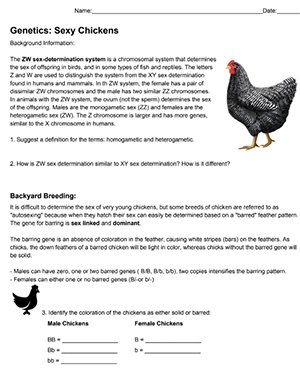
This worksheet was designed for advanced students of biology or for honors students who are ready for an extra challenge. Birds have a ZW sex determination system instead of the XY system seen in humans. If your students have a good grasp on sex-linked traits in humans, then this scenario is a way to really challenge their thinking.
In birds, it is the female that is heterogametic (ZW) and the ovum determines the sex of the offspring. Males are ZZ and can only contribute Z sperm to the next generation, similar to human females (XX).
Students are then challenged to examine crosses that involved the “barred” gene, which is sex-linked and dominant. The barred pattern makes the chickens’ feathers appear striped. Males can be BB or Bb (barred) or bb (solid), but females will either be B (barred) or b (solid).
Students complete Punnett squares to make predictions about the offspring of the crosses and ultimately determine how choosing the pattern of the parents can make sexing baby chicks simple (certain breeds of chicken are considered to be “autosexing” due to this gene.)
I do not recommend this for introductory or freshman biology, mainly because those students are just grappling with sex-linked genes and this can really cause some confusion. Genetics can be challenging for beginners to keep straight the rules about sex-linkage and codominance, adding another type of pattern can sometimes just be too much, though it really depends on your students.
Learn Genetics has an entire unit on pigeon genetics which includes an interactive activity on the ZW sex determination system:
https://learn.genetics.utah.edu/content/pigeons/
Time Required: 15-20 minutes
Grade Level: 10-12
HS-LS3-1 Ask questions to clarify relationships about the role of DNA and chromosomes in coding the instructions for characteristic traits passed from parents to offspring.

